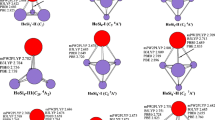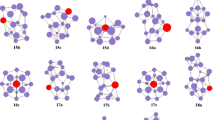Abstract
The total energies, growth patterns, equilibrium geometries, relative stabilities, hardnesses, intramolecular charge transfer, and magnetic moments of HoSi n (n = 12–20) clusters have been reexamined theoretically using two different density functional schemes in combination with relativistic small-core Stuttgart effective core potentials (ECP28MWB) for the Ho atoms. The results show that when n = 12–15, the most stable structures are predicted to be exohedral frameworks with a quartet ground state, but when n = 16–20, they are predicted to be endohedral frameworks with a sextuplet ground state. These trend in stability across the clusters (gauged from their dissociation energies) was found to be approximately the same regardless of the DFT scheme used in the calculations, with HoSi13, HoSi16, HoSi18, and HoSi20 calculated to be more stable than the other clusters. The results obtained for cluster hardness indicated that doping the Ho atom into Si13 and Si16 leads to the most stable HoSi n clusters, while doping Ho into the other Si n clusters increases the photochemical sensitivity of the cluster. Analyses of intracluster charge transfer and magnetic moments revealed that charge always shifts from the Ho atom to the Si n cluster during the creation of exohedral HoSi n (n = 12–15) structures. However, the direction of charge transfer is reversed during the creation of endohedral HoSi n (n = 16–20) structures, which implies that Ho acts as an electron acceptor when it is encapsulated in the Si n cage. Furthermore, when the most stable exohedral HoSi n (n = 12–15) structures are generated, the 4f electrons of Ho are virtually unchanged and barely participate in intracluster bonding. However, in the most stable endohedral HoSi n (n = 16–20) frameworks, a 4f electron does participate in bonding. It does this by transferring to the 5d orbital, which hybridizes with the 6s and 6p orbitals and then interacts with Si valence sp orbitals. Meanwhile, the total magnetic moments of the HoSi n (n = 16–20) clusters are considerably higher than those of HoSi n (n = 12–15). Interestingly, the endohedral HoSi16 and HoSi20 clusters can be viewed as the most suitable building blocks for novel high-density magnetic storage nanomaterials and for novel optical and optoelectronic photosensitive nanomaterials, respectively.







Similar content being viewed by others
Explore related subjects
Discover the latest articles and news from researchers in related subjects, suggested using machine learning.References
Raghavachari K (1986) J Chem Phys 84:5672–5686
Li BX, Cao PL, Zhan SC (2003) Phys Lett A 316:252–260
Vasiliev I, Öğüt S, Chelikowsky JR (1997) Phys Rev Lett 78:4805–4808
Grossman JC, Mitáš L (1995) Phys Rev Lett 74:1323–1326
Zhu X, Zeng XC (2003) J Chem Phys 118:3558–3570
Zhu X, Zeng XC, Lei YA, Pan B (2004) J Chem Phys 120:8985–8995
Yoo S, Zeng XC (2005) J Chem Phys 123:164303-1–164303-6
Yoo S, Zeng XC (2006) J Chem Phys 124:054304-1–054304-6
Nigam S, Majumder C, Kulshreshtha SK (2006) J Chem Phys 125:074303-1–074303-11
Li S, Zee RJV, Weltner W Jr (1994) J Chem Phys 100:7079–7086
Xu CS, Taylor TR, Burton GR, Neumark DM (1998) J Chem Phys 108:1395–1406
Ohara M, Koyasu K, Nakajima A, Kaya K (2003) Chem Phys Lett 371:490–497
Honea EC, Ogura A, Peale DR, Félix C, Murray CA, Raghavachari K, Sprenger WO, Jarrold MF, Brown WL (1999) J Chem Phys 110:12161–12171
Li S, Zee RJV, Weltner W Jr, Raghavachari K (1995) Chem Phys Lett 243:275–280
Koyasu K, Atobe J, Furuse S, Nakajima A (2008) J Chem Phys 129:214301-1–214301-7
Grubisic A, Ko YJ, Wang H, Bowen KH (2009) J Am Chem Soc 131:10783–10790
Li J, Wang G, Yao C, Mu Y, Wan J, Han M (2009) J Chem Phys 130:164514-1–164514-9
Zhao G, Sun J, Gu Y, Wang Y (2009) J Chem Phys 131:114312-1–114312-7
Peng Q, Shen J (2008) J Chem Phys 128:084711-1–084711-11
Liu T, Zhao G, Wang Y (2011) Phys Lett A 375:1120–1127
Dhaka K, Bandyopadhyay D (2015) RSC Adv 5:83004–83012
Li Y, Tam NM, Claes P, Woodham AP, Lyon JT, Ngan VT, Nguyen MT, Lievens P, Fielicke A, Janssens E (2014) J Chem Phys A 118:8198–8203
Kenyon AJ (2005) Semicond Sci Technol 20:R65–R84
Ohara M, Miyajima K, Pramann A, Nakajima A, Kaya K (2002) J Chem Phys A 106:3702–3705
Yang JC, Wang J, Hao YR (2015) Theor Chem Accounts 134:81-1–81-11
Xie XH, Hao DS, Liu YM, Yang JC (2015) Comput Theor Chem 1074:1–8
Xie XH, Hao DS, Yang JC (2015) Chem Phys 461:11–19
Li CG, Pan LJ, Shao P, Ding LP, Feng HT, Luo DB, Liu B (2015) Theor Chem Accounts 134:34-1–34-11
Wang HQ, Li HF (2014) RSC Adv 4:29782–29793
Zhao RN, Han JG, Bai JT, Sheng LS (2010) Chem Phys 378:82–87
Zhao RN, Han JG, Bai JT, Liu FY, Sheng LS (2010) Chem Phys 372:89–95
Zhao RN, Ren ZY, Guo P, Bai JT, Zhang CH, Han JG (2006) J Phys Chem A 110(11):4071–4079
Cao TT, Zhao LX, Feng XJ, Lei YM, Luo YH (2009) J Mol Struct 895:148–155
Cao TT, Feng XJ, Zhao LX, Liang X, Lei YM, Luo YH (2008) Eur Phys J D 49:343–351
Kumar V, Singh AK, Kawazoe Y (2006) Phys Rev B 74:125411-1–125411-5
Wang J, Liu Y, Li YC (2010) Phys Chem Chem Phys 12:11428–11431
Liu TG, Zhang WQ, Li YL (2014) Front Phys 9:210–218
Zhao RN, Han JG (2014) RSC Adv 4:64410–64418
Adamo C, Barone V (1999) J Chem Phys 110:6158–6170
Becke AD (1993) J Chem Phys 98:5648–5652
Lee C, Yang W, Parr RG (1988) Phys Rev B 37:785–789
Woon DE, Dunning TH Jr (1993) J Chem Phys 98:1358–1371
Cao X, Dolg M (2002) J Mol Struct THEOCHEM 581:139–147
Frisch MJ, Trucks GW, Schlegel HB et al (2010) Gaussian 09, revision C.01. Gaussian Inc., Wallingford
Acknowledgments
This work was supported by the National Natural Science Foundation of China (grant no. 21263010), by the Program for Innovative Research Team in Universities of the Inner Mongolia Autonomous Region (grant no. NMGIRT-A1603), and by the Inner Mongolia Natural Science Foundation (grant no. 2015MS0216).
Author information
Authors and Affiliations
Corresponding author
Rights and permissions
About this article
Cite this article
Hou, L., Yang, J. & Liu, Y. Reexamination of structures, stabilities, and electronic properties of holmium-doped silicon clusters HoSi n (n = 12–20). J Mol Model 22, 193 (2016). https://doi.org/10.1007/s00894-016-3058-1
Received:
Accepted:
Published:
DOI: https://doi.org/10.1007/s00894-016-3058-1




